your current location is:Home > Finance > depthHomedepth
Silicon Valley "earthquake": Microsoft, Google, Facebook, three giants, miserable, miserable, miserable
 In the financial reports of tech giants, one thunderstorm is bigger than the other.
In the financial reports of tech giants, one thunderstorm is bigger than the other. Silicon Valley "earthquake".
This earthquake not only refers to the 5.1-magnitude earthquake with San Jose as the epicenter yesterday morning, but also the dismal performance and stock price performance of the three major giants: the US stock market is due to the poor performance of Silicon Valley technology giants one after another . And vibrated violently.
As of Wednesday local time, Microsoft, Google, and Meta have released the latest financial report data. The results show that the performance of the three giants continued to deteriorate compared with the second quarter, refreshing the lowest revenue growth rate and net profit in recent years respectively. The group has been greatly reduced, and various sub-businesses have also shown varying degrees of weakness.
After the after-hours financial report was released, the stock prices of Google and Microsoft plummeted by more than 6%, and Meta plummeted by nearly 20% again. Previously, under the recent downturn in the U.S. stock market, many investors pinned their growth hopes on a few giants to boost confidence. But at present, it seems that, let alone saving the market, it is good not to frantically smash the market.
|Meta "free fall" again: Net income plummeted by 52% year-on-year, and Metaverse business did not rise but fell
In fact, after the poor performance of Microsoft and Google was announced yesterday, in today's trading session, Meta has been "scared" and fell nearly 6%. But when the results were really announced, everyone was shocked to realize that the 6% decline was just an appetizer. After the U.S. stock market closed today, Meta’s stock price plummeted by nearly 20%, with a cumulative decline of more than 25% throughout the day. The market value in a single day once again evaporated by more than 8 billion US dollars.
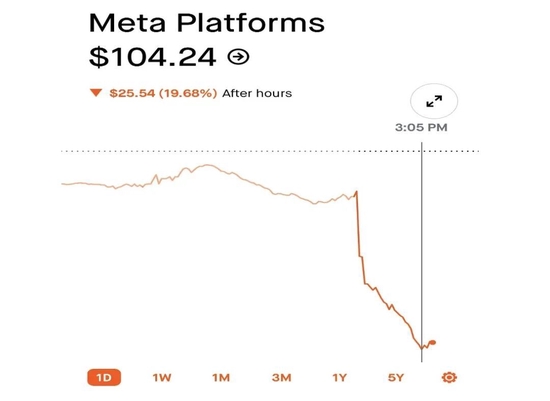 Meta's stock price plummeted after hours, picture taken from Robinhood
Meta's stock price plummeted after hours, picture taken from RobinhoodSo, what kind of information did Meta’s financial report reveal this time, which made the market’s confidence plummet again?
According to the financial report, Meta’s operating income in the third quarter was US$27.71 billion, slightly higher than analysts’ expectations, but down 4% year-on-year and continued to decline month-on-month; daily active users were 1.98 billion and monthly active users were 2.96 billion, which were flat and slightly higher than market expectations, respectively. 20 million. While these two key operating metrics don't appear to be outrageously bad, the problem is that Meta's expenses are expanding significantly without revenue growth or even falling, resulting in continued declines in profit margins.
Last quarter, Meta's costs and expenses were $22.1 billion, an increase of nearly 19% year over year. As a result, its net income plummeted 52% from $9.19 billion a year ago and earnings per share of $3.22 to $4.4 billion this quarter, with earnings per share of only $1.64, far below market expectations.
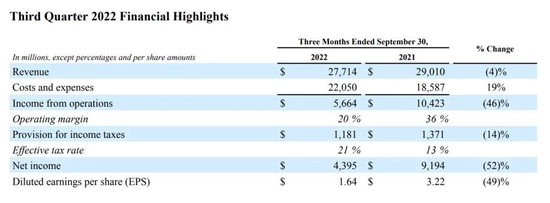 Meta's revenue and profit growth in the third quarter, the picture comes from Meta's financial report
Meta's revenue and profit growth in the third quarter, the picture comes from Meta's financial reportWhat's worse is that this trend of low revenue and high cost will continue to expand. Meta said in the earnings report that it expects fourth-quarter revenue to be between $30 billion and $32.5 billion, the third straight quarter of declines, and below analysts' expectations of $32.2 billion. But at the same time, total spending in 2023 will be between $96 billion and $101 billion, well above the $85 billion forecast for 2022.
From the perspective of sub-businesses, the advertising revenue of Family apps was obviously weak, showing a slight year-on-year decline. And the closely watched Metaverse division Reality Labs saw not only no growth but a sharp drop in revenue. The division's revenue nearly halved from a year earlier, from $558 to $285 million, the report showed. But losses nearly halved to $367 million from $2.63 a year earlier.
Seeing the data of Reality Labs, I believe everyone has a question mark in their hearts. Burning more than 10 billion US dollars, where did the money in the Meta universe go?
"We expect Reality Labs' 2023 operating loss to grow significantly year-over-year," Meta said at the earnings call. After 2023, we expect to accelerate the pace of Reality Labs' investments to achieve its goal of increasing the company's overall operating income in the long run. ” As of this quarter of this year, Reality Labs has lost a cumulative $9.4 billion in business, and it seems that the metaverse that Meta is betting on is still a bottomless pit.
Since the beginning of this year, Meta's "embarrassed" situation has continued to intensify, and it is more vulnerable than other giants. First, it was challenged by the rise of TikTok and Apple's new privacy regulations, which caused a severe impact on the online advertising business that it depends on; then it was a desperate gamble on the Metaverse, and nearly a year later, there was still no improvement, but it became a "gold swallowing beast"; now Affected by the economic downturn, Meta, which was already struggling, was once again in trouble.
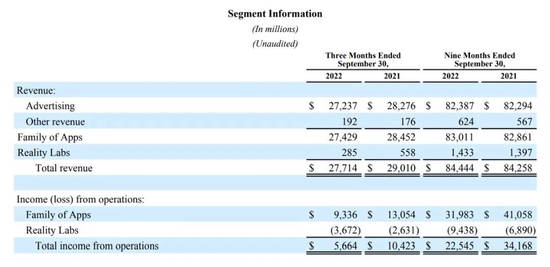 Meta's revenue by sub-sector in the third quarter, the picture comes from Meta's financial report
Meta's revenue by sub-sector in the third quarter, the picture comes from Meta's financial reportFacing the prospect full of uncertainty, Meta will now be bound to retrench and prepare for the winter. At this earnings report, Meta made it clear that in the next period of time, Meta will only invest in the company's highest priorities, and will significantly reduce the growth of other teams' headcount.
It is said that confidence is more important than gold, but Meta's earnings reports one after another this year are undoubtedly giving market confidence a heavy blow again and again.
| Microsoft: Revenue growth fell to the lowest in 5 years, Azure has been lower than expected for two consecutive quarters
After seeing the precarious Meta, let us pay attention to the stable Microsoft.
Yesterday, after the US stock market closed, Microsoft released its financial report for the first quarter of fiscal year 2023. The financial report shows that Microsoft’s revenue in this quarter was $50.122 billion, an increase of 11% year-on-year; net profit was $17.556 billion, a year-on-year decrease of 14%; earnings per share were $2.35, It was $2.71 a year earlier. Although both revenue and earnings per share were slightly higher than market expectations, compared with the same period last year, all key financial indicators fell by more than 10%, and its revenue even recorded the lowest growth since fiscal 2018. Record.
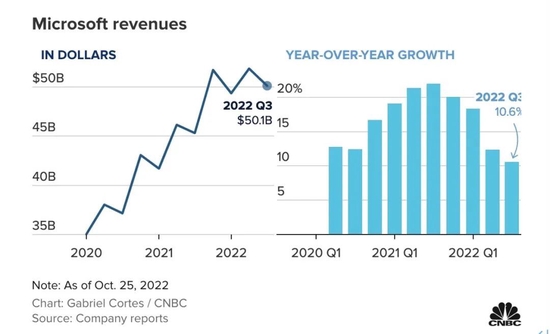 Image via CNBC
Image via CNBCFrom the perspective of sub-business, although Microsoft's various businesses have basically met market expectations this quarter, they have just passed the level of passing the line, and there is nothing outstanding. The Productivity and Business Processes segment, which primarily includes Office software, had revenue of $16.5 billion, up 9 percent year-over-year, while the More Personal Computing segment, which includes businesses such as Windows, Surface devices and Xbox, edged down to $13.3 billion.
For the intelligent cloud business, which the market is particularly concerned about, this quarter has become a major factor that caused Microsoft's stock price to plummet. Intelligent cloud revenue was $20.3 billion, up 20% year-on-year. Although the overall figure was basically in line with expectations, the revenue growth rate of Azure cloud computing services slowed to 35%. You know, from the beginning of 2020 to the last quarter, the growth of Azure has been maintained at more than 45%. Although Microsoft stated that the decline in revenue was largely due to exchange rate factors, according to calculations, even at a constant exchange rate, Azure’s revenue growth was only 42%, which was still lower than market expectations.
After the earnings report was released, Microsoft’s stock price tumbled nearly 7%. And just this month, Microsoft also officially announced a 1% layoff involving more than a thousand people. According to information disclosed by Microsoft at the earnings conference, it seems that such weakness will continue in the short term.
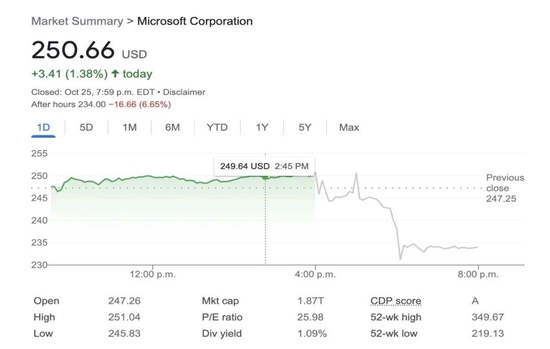 Image taken from Google
Image taken from GoogleSince nearly half of Microsoft's revenue comes from overseas markets, and the recent strong trend of the US dollar exchange rate has greatly affected Microsoft's overseas revenue, Microsoft expects that the exchange rate factor will cause the annual sales growth to decline by 5%. In addition, sharply rising energy prices have increased the cost of providing cloud services and will continue to thin cloud business profit margins.
| "Blood collapse" Google: Net profit plummeted 26% year-on-year, and the growth rate fell back to the lowest level in 2013
After Snap's earnings tumbled nearly 30% last week, everyone is worried about the tech companies that make a living from advertising. It turns out that Snap's sharp decline in performance is not an isolated case, but the entire online advertising market has been hit hard in this economic downturn.
Google’s third-quarter financial report shows that Google’s revenue in the quarter was $69.092 billion, a year-on-year increase of 6%; net profit was $13.910 billion, a year-on-year decrease of 26.5%; earnings per share were $1.06, a year-on-year decrease of 24.3%.
Not only are almost all key indicators lower than Wall Street's expectations, it is worth noting that Google's 6% revenue growth rate this time can be said to have dropped sharply compared to the 41% growth rate in the same period last year. At the same time, this data also excludes the new crown epidemic. The lowest level since 2013 after the outbreak.
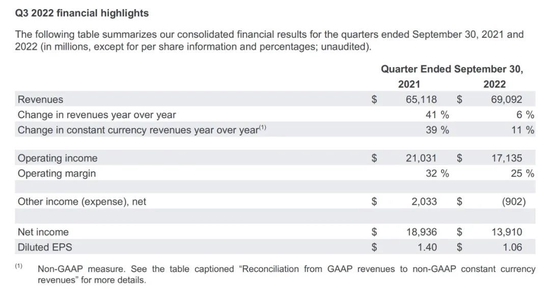 Google's third-quarter financial report, the picture comes from Google
Google's third-quarter financial report, the picture comes from GoogleFrom the perspective of the key advertising business, its growth rate was significantly lower than market expectations. Among them, Google’s search and other business revenue in the third quarter was 39.539 billion US dollars, which only increased slightly year-on-year. Another important problem in this advertising business is that YouTube’s revenue did not increase but declined. The recorded revenue was 7.07 billion US dollars, which is far lower. than the expected $7.42 billion.
In contrast, the performance of the other two businesses this time is fairly passable. Among them, Google Cloud recorded revenue of $6.9 billion, which was higher than market expectations of $6.69 billion. The other bets business also saw some improvement, with revenue rising to $209 million while losses narrowed slightly. However, since these two businesses accounted for too little of the total revenue, they were unable to turn the tide.
After the financial report was released, Google’s stock price fell by more than 9% today, setting a record for the highest single-day decline this year.
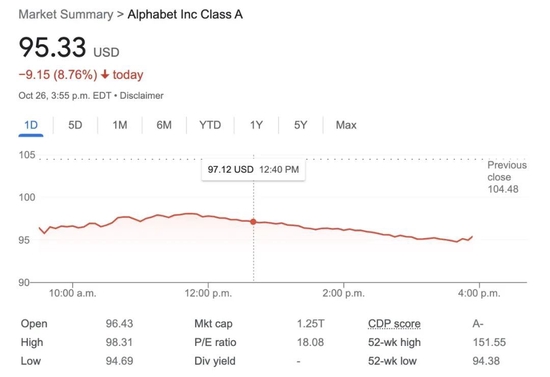
In fact, from the slightly "wolf-like" signals that Google has previously released, we can roughly read that this quarter's performance will not be very good.
In September, Pichai said that he wanted to increase the company's efficiency by 20%, and did not rule out layoffs and product cuts. Immediately after, Google canceled the release plan of this year's new generation of Pixelbook laptops, and directly shut down some projects of Google's internal incubator Area 120. Just last month, Stadia, an online game service platform that Google had spent a lot of manpower and financial resources on, was also announced to shut down.
Judging from the news released at this earnings conference, Google's "wolf-like" atmosphere should increase unabated in the next period of time. It had about 186,800 full-time employees at the end of the third quarter, compared with about 150,000 last year. Pichai said that as the company "focuses on slowing operating expense growth" next, the number of new hires in the fourth quarter will be "significantly lower" than the third quarter, to less than half the number of new hires in the third quarter. .
In addition, according to the signals revealed at this meeting, the trend of Google's personnel reduction will continue into next year. "Our actions to slow down hiring will become more apparent in 2023," Pichai said.
According to data from FactSet, Wall Street analysts had previously lowered their forecasts for U.S. stocks in the third quarter, the largest reduction since the outbreak of the epidemic in 2020. But even after the downgrade, many companies still underperform.
This week, in addition to the above three companies, Amazon and Apple will also soon announce their results. This quarter, we will wait and see whether the giants will be wiped out or if someone will successfully break through in the cold winter.
related articles
Article Comments (0)
- This article has not received comments yet, hurry up and grab the first frame~












